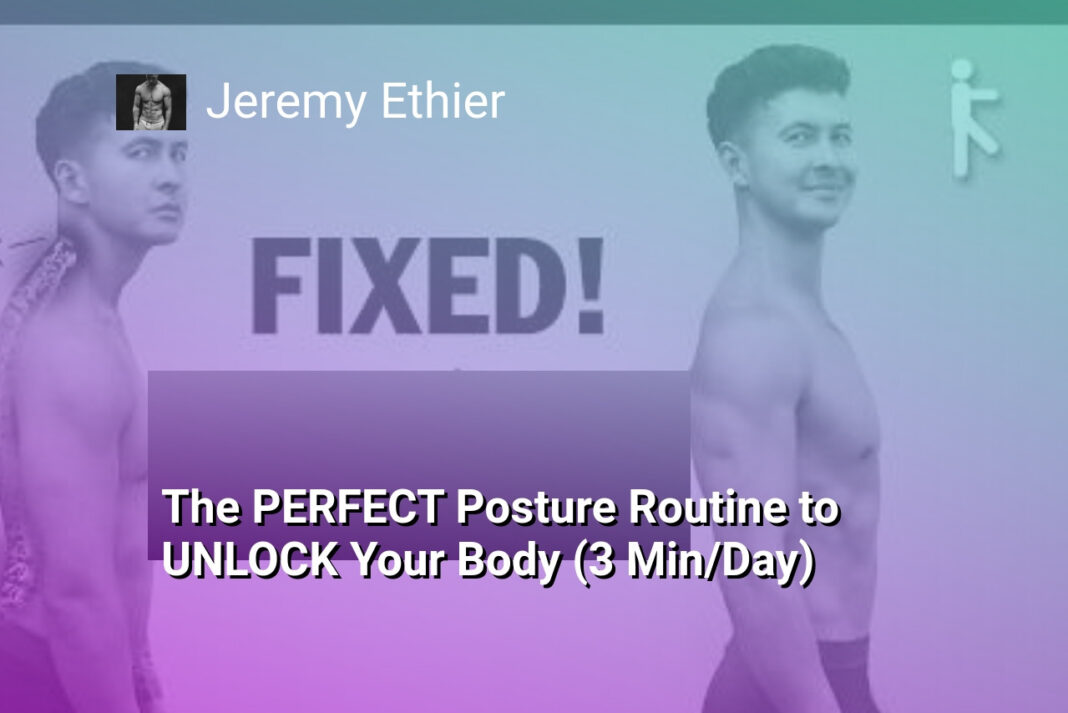The Bottom Line:
- The text discusses how sitting for long periods can lead to muscle stiffness and poor posture, and provides a 3-minute daily routine of three simple exercises to help reverse these effects.
- The exercises target the shoulders, back, neck, and hips, which are the areas most affected by prolonged sitting.
- The exercises involve movements that contract and stretch the muscles, improving range of motion and posture.
- The text emphasizes the importance of consistency, recommending starting with a few times per week and working up to once or twice daily.
- The text also suggests that the exercises are a more effective solution than using electrical stimulation devices, and that they can be complemented by an additional exercise for preventing aches and pains and burning fat.
The Surprising Findings from a Sitting Study
Reversing Sitting-Induced Muscle Stiffness
The researchers in this study were interested in understanding how sitting for prolonged periods affects muscle stiffness and whether there are ways to counteract these negative effects. They split the participants into three groups: a control group that simply sat without any intervention, a group that received low-level electrical stimulation, and a group that received high-amplitude electrical stimulation to their back muscles.
The Surprising Findings
As expected, the control group and the low-level stimulation group both experienced increased muscle stiffness in their backs after the 4.5 hours of sitting. This is a common phenomenon that occurs when the body’s muscles are inactive for an extended period, leading to a loss of mobility and the sensation of stiffness.
However, the real surprise came from the group that received the high-amplitude electrical stimulation. In this group, the researchers found that the stiffness in the participants’ backs was almost completely reversed. The electrical stimulation caused the muscles to contract, mimicking the effects of exercise, and preventing the sitting-induced stiffness from setting in.
The Takeaway for You
While having access to a neuromuscular electrical stimulator might not be a practical solution for most people, the key takeaway from this study is that actively contracting the muscles that are typically underused during prolonged sitting can effectively counteract the negative effects of a sedentary lifestyle.
By incorporating targeted exercises that focus on the shoulders, back, and hips – the areas most affected by sitting – you can regain mobility, improve your posture, and reduce the feelings of stiffness and discomfort that often come with a desk-bound job or lifestyle. The three exercises outlined in the next section are designed to address these issues and provide a simple, effective solution to reverse the effects of sitting.
The Key to Reversing Muscle Stiffness
Unlocking the Power of Electrical Stimulation
The researchers in the study made a fascinating discovery – by applying high-amplitude electrical currents to the participants’ back muscles, they were able to reverse the stiffness that had developed from prolonged sitting. The electrical stimulation caused the muscles to contract, just like during exercise, and this counteracted the effects of inactivity.
Effective Exercises to Reverse Sitting Stiffness
While electrical stimulation may not be a practical solution for most people, the good news is that simple exercises can achieve similar results. By targeting the specific muscle groups that become stiff and weak from sitting, you can restore mobility and improve your overall posture and range of motion.
A Comprehensive 3-Minute Routine
The key is to focus on the three main problem areas: the shoulders, back/neck, and hips. The exercises provided in this section address each of these areas, starting with a wall clock movement to open up the shoulders, followed by a back and neck stretch to reactivate the spinal muscles, and finally a hip-focused exercise to regain mobility in the lower body. By dedicating just 3 minutes per day to this routine, you can reverse the damaging effects of prolonged sitting and feel more energized and flexible throughout the day.
Exercise 1: The Wall Clock for Shoulder Mobility
Unlocking Shoulder Mobility with the Wall Clock Exercise
The wall clock exercise is a powerful tool for improving rounded, locked-up shoulders. This movement not only loosens the deltoids and chest muscles but also strengthens the weakened muscles in the upper back and shoulders, leading to long-term posture improvements.
To perform the wall clock exercise, stand sideways with your fingertips touching the wall, and your thumb pointing down. Engage your core, and without arching your back, slowly draw your palm in a big semicircle forward and up the wall. As you do so, let your shoulder blade move forward and then up, and you should feel a stretch in your chest on the way up, as well as some of your shoulder and upper back muscles working.
Once you’ve reached the top of the semicircle, reverse the movement, moving your arm back and down the wall, allowing your shoulder blade to move back and down as your arm travels behind you. Repeat this cycle for about 30 seconds on each side.
The beauty of this exercise is that you can adjust the intensity based on your comfort level. The closer you stand to the wall, the more challenging the stretch will be. However, it’s important not to overdo it, especially if you’re experiencing any pain or discomfort. Aim for a stretch that feels like a 4 or 5 out of 10, and focus on maintaining proper form throughout the movement.
Activating the Back and Neck Muscles
Another common issue when sitting for extended periods is the stiffness and lack of mobility in the back and neck. This exercise is designed to contract these muscles, completely reversing the sitting position and allowing them to move through their full range of motion.
Start by getting on all fours, with your hands directly under your shoulders. Engage your lats by spinning your elbows towards your thighs. Inhale and gently lift your tailbone towards the ceiling, reaching your chest forward through your biceps to stretch your abs. As you do this, squeeze your shoulder blades together and lift your chin up towards the ceiling.
Next, exhale and imagine there’s a rope pulling your mid-back up towards the ceiling, rounding your spine. At the same time, push the floor away to open up your shoulder blades, and use your neck muscles to tuck your chin by looking towards your knees or belly button. You should feel a deep stretch in your back muscles, as well as your neck.
Repeat this sequence for about 30 seconds, then spend the next 30 seconds turning and looking towards your left foot, followed by the right foot. This will stretch the muscles on the sides of your lower back and rib cage.
Improving Hip Mobility with the Seated Hip Hinge
The final exercise in this routine targets the hips, which are often locked into a single position when sitting for long periods. The seated hip hinge movement will move your hips through a variety of positions while strengthening the muscles that tend to weaken from excessive sitting.
Start by sitting on the floor with one leg bent in front of you at a 90-degree angle, and the other leg in the same position behind you. You can use your hands for support if needed. Sit up tall, keeping your shoulders square to the front of your shin, and exhale as you reach your chest forward, hinging at the hip to feel a deep stretch on the outside of your front leg’s hip or glute area. Avoid rounding your spine, and focus on bending at the hip.
For the next level, as you lean forward, push your front shin down into the ground and lift your hips up to get your torso upright. You should feel your glute muscles working, as well as a stretch in the hip flexors and groin of your back leg. Slowly lower back down, leaning forward again.
The final level involves a “windshield wiper” motion, where you’ll transition your knees directly over to the other side on the way down, and then repeat the movement back and forth. Reach your arms out in front of you and engage your core during the transition, using your hands for support if needed.
Remember, these exercises are just the beginning. To truly fix your posture and mobility issues for good, there’s one more underrated exercise you’ll want to add to your routine. Check out the next video to learn more.
Exercise 2: The Back and Neck Stretch Routine
Unleashing the Power of Back and Neck Stretches
The second exercise in our routine focuses on the often-neglected areas of the back and neck. When you’ve been sitting for an extended period, the first instinct is to stretch your back, as your body is essentially telling you to wake up and use those dormant muscles. However, there’s a more effective way to contract them, completely reverse the sitting position, and guide them through their full range of motion.
The Back and Neck Stretch
Begin by getting on all fours, with your hands directly under your shoulders. Engage your lats by turning your elbows towards your thighs. Inhale and gently lift your tailbone towards the ceiling, reaching your chest forward through your biceps to stretch your abs. Simultaneously, squeeze your shoulder blades together and lift your chin up towards the ceiling. This is the first half of the exercise.
Now, exhale and imagine there’s a rope pulling your mid-back up towards the ceiling, rounding your spine. Push the floor away to open up your shoulder blades, and use your neck muscles to tuck your chin by looking towards your knees or even your belly button. You should feel a deep stretch in your back muscles, as well as your neck.
Repeat this sequence for about 30 seconds, then transition to the next 30-second segment. Come back to a neutral position and turn to look towards your left foot, stretching the muscles on the right side of your lower back and rib cage. Return to center, then repeat the same motion on the other side, looking towards your right foot.
Unlocking the Hips
The final exercise in our 3-minute routine targets the hips, which are often locked into a single position when you sit all day. This exercise moves the hips through a variety of positions while strengthening the muscles that weaken from excessive sitting.
Start with the level one variation: Sit on the floor with one leg bent in front of you at a 90-degree angle, and the other leg in the same position behind you. Use your hands for support if needed. Sit up tall, keeping your shoulders square to the front of your shin, and exhale as you reach your chest forward, hinging at the hip to feel a deep stretch on the outside of your front leg’s hip or glute area. Inhale as you return to the starting position. Repeat for 30 seconds on each side.
For level two, maintain the same 90-degree leg position, but as you lean forward, push your front shin down into the ground and lift your hips up to get your torso upright. You should feel your glute muscles working and the hip flexors and groin muscles of your back leg stretching. Slowly lower back down, then repeat for 30 seconds on each side.
Finally, level three builds on the previous variation by adding a “windshield wiper” motion. As you lean forward and push your shin down, directly shift your knees over to the other side, then repeat the motion back to the starting position. Engage your core and use your arms for support as needed. Aim for 30 seconds on each side.
Remember, these exercises are just the beginning. To truly transform your posture and mobility, there’s one more crucial element you’ll want to add to your routine. Stay tuned for the next video to discover this powerful, yet often overlooked, exercise.
Exercise 3: The Multi-Directional Hip Mobility Sequence
Unlocking Your Hips: The Multi-Directional Hip Mobility Sequence
When you sit for extended periods, your hips become locked into a single position, limiting their natural range of motion. This exercise sequence is designed to move your hips through a variety of directions, strengthening the muscles that weaken from prolonged sitting.
Level 1: Foundational Hip Mobility
Start by sitting on the floor, with one leg bent in front of you at a 90-degree angle and the other leg in the same position behind you. Use your hands for support if needed. Sit up tall, keeping your shoulders square to the front of your shin. Exhale as you reach your chest forward, hinging at the hips to feel a deep stretch on the outside of your front leg’s hip or glute area. Avoid rounding your spine. Inhale as you return to the starting position. Repeat for 30 seconds on each side, aiming to go deeper into the stretch with each repetition.
Level 2: Activating the Weak Muscles
Maintain the same 90-degree leg position, but this time, as you lean forward, push your front shin down into the ground and lift your hips up to get your torso upright. You should feel your glute muscles working, and the hip flexors and groin muscles of your back leg stretching. Slowly lower back down, leaning forward again. Aim for 30 seconds on each side.
Level 3: Multidirectional Hip Mobility
In this advanced variation, you’ll repeat the Level 2 movement, but instead of sticking to one side, you’ll “windshield wiper” your knees directly over to the other side on the way down, and then repeat the motion back. This will provide a deeper stretch in your groin and hip flexors. Reach your arms out in front of you and engage your core during the transitions. Use your hands for support if needed.
Remember, these exercises are designed to restore mobility and prevent aches and pains. Start by incorporating them a few times per week, and work towards doing them once or twice daily to break up your sitting time.





